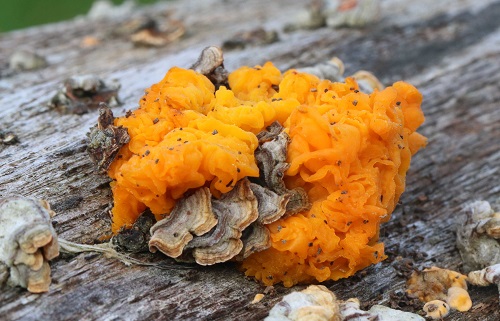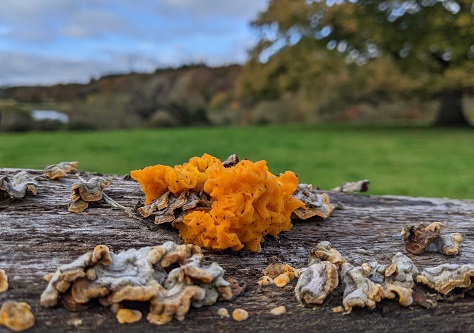The Vyne
Thu 18 Nov 2021
Field event ID HF2134
Report: This was a joint excursion with the Thames Valley Group in the grounds of the 16th century country house owned by the National Trust. We explored the extensive lawns and woodland of the estate under the guidance of Mike Harrison. It remained dry but was overcast with a chill north-westerly breeze.
The grassland held a few bonnets including Mycena olivaceomarginata (Brownedge Bonnet) and M. flavoalba (Ivory Bonnet) as well as Clavaria acuta (Pointed Club), Coprinus comatus (Shaggy Inkcap) and Parasola plicatilis (Pleated Inkcap).
A sloping lawn dotted with pines had a scattering of Tricholoma terreum (Grey Knight), some of which were sporting dew drops on their caps. Here also, we found an emerging spike of Agaricus augustus (The Prince) and a clump of Lepista luscina (Spotted Blewit).
We then walked along the riverbank, where there was a fine clump of Pholiota squarrosa (Shaggy Scalycap), before crossing marshy ground beside a lake, flushing a Snipe in the process. We then climbed up another grass slope which gave nice views over the lake to the woods beyond. A single spike of Psilocybe semilanceata (Liberty Cap) was recorded before we examined the remains of a burnt Horse-chestnut tree and an adjacent fallen oak. These both provided us with some good finds.
In the hollow stump of the Horse-chestnut there was a striking poroid crust fungus, Oxyporus latemarginatus (Frothy Porecrust) and at the base of the tree a large clump of Coprinellus disseminatus (Fairy Inkcap). Schizophyllum commune (Splitgill) was found on some of the fallen branches.
Moving to the prostrate oak we were immediately enchanted by the jelly fungus, Tremella aurantia (Golden Ear) a parasitic species that was growing on its fungal host, Stereum hirsutum (Hairy Curtain Crust). Other species seen here included Bisporella citrina (Lemon Disco) and the tiny Clitopilus hobsonii (Miller’s Oysterling).
We made use of the trunk to sit and have our lunches during which Mike handed to Eric a most beautiful little coral fungus for him to take away and analyse. It had been collected the previous week from a farm at Whitchurch-on-Thames in the neighbouring county of Berkshire. It was of a delicate lilac-pink colour, no more than 2cm tall and growing on organic matter. It was thought to be Ramariopsis pulchella (Lilac Coral).
In the afternoon, we made a short exploration of a damp willow carr, where we found a large and impressive yellow Cortinarius, Hemimycena tortuosa (Dewdrop Bonnet) and Kuehneromyces mutabilis (Sheathed Woodtuft).
We returned through mixed woodland adding a few more species including Russula cyanoxantha (Charcoal Burner), Fistulina hepatica (Beefsteak Fungus) and Lepista cristata (Stinking Dapperling). Perhaps the best find here was a clump of Hypholoma lateritium (Brick Tuft).
It had been another good foray and a chance to get to know members of another group.
















